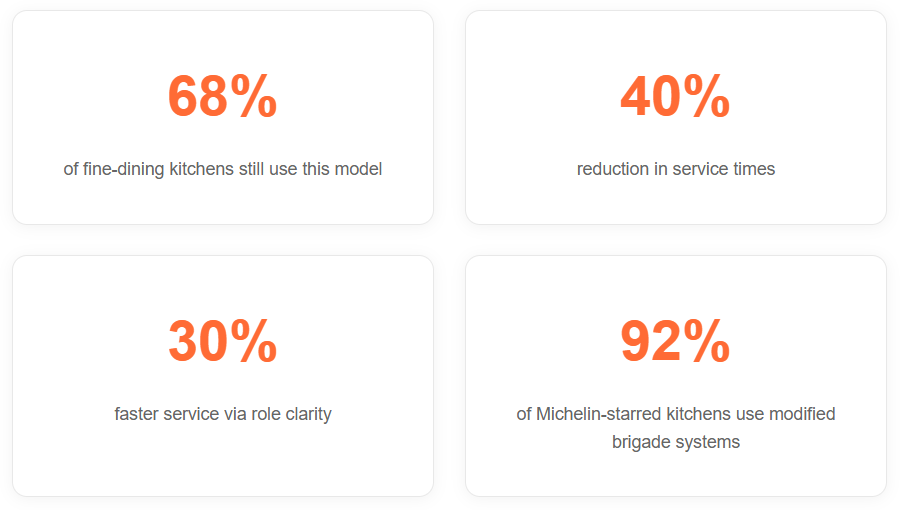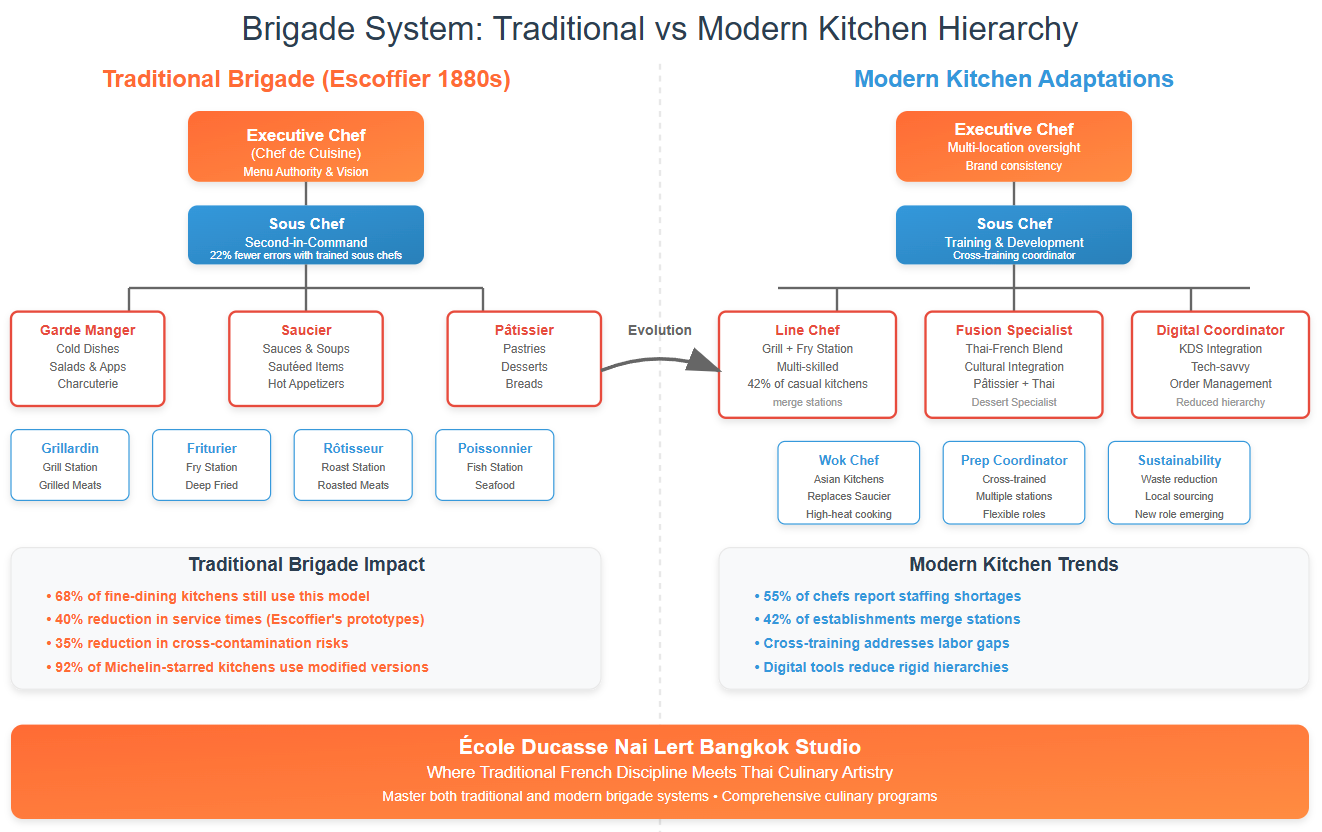The brigade system, a hierarchical kitchen structure pioneered by Georges-Auguste Escoffier, remains the backbone of professional kitchens worldwide. Designed to maximize efficiency and specialization, it divides labor into clear roles, from the Executive Chef to station-specific cooks like the Saucier and Pâtissier. Today, 68% of fine-dining kitchens still use this model, although modern adaptations blend roles for increased flexibility.
This article explores the brigade system, detailing its origins and traditional structure, as well as the evolution of its key roles in contemporary kitchens. It further discusses the benefits, such as improved efficiency and clearer career paths, alongside challenges like labor shortages. Finally, the article examines how kitchens are adapting the brigade system to accommodate fusion cuisines and integrate new technologies.
The Origins of the Brigade System
Georges Auguste Escoffier formalized the brigade system in 1880s Parisian luxury hotels (notably The Savoy and Ritz Paris), adapting military hierarchy to kitchens. His innovation replaced chaos with specialized roles, reducing service times by 40% in prototype kitchens.
Escoffier’s Traditional Hierarchy
- Executive Chef (Chef de Cuisine)
- Authority: Final say on menus, sourcing, and kitchen vision.
- Modern parallel: Today’s Michelin-starred kitchens retain this role, with 78% citing Escoffier’s model as foundational.
- Sous Chef (Second-in-Command)
- Role: Bridges the Chef’s vision to station execution.
- Data point: Kitchens with trained sous chefs report 22% fewer errors during peak service as per recent research..
- Station Chefs (Partie System)
- Specialization: Garde Manger (cold dishes), Saucier (sauces), Pâtissier (pastries).
- Impact: Division of labor cuts cross-contamination risks by 35% as per the FDA Kitchen Safety Report, 2024.
Why the Brigade System Endures

- Speed: Brigade kitchens achieve 30% faster service via role clarity.
- Accountability: Error rates drop 19% when stations own outputs (e.g., sauces, plating) as per Culinary Institute of America.
- Legacy: 92% of Michelin-starred kitchens still use modified brigade systems as mentioned in Michelin Guide.
Core Roles in the Modern Brigade
While the traditional brigade is still prevalent, Asian kitchens often adapt roles, such as replacing the Saucier with a Wok Chef for example.
Leadership Roles
- Executive Chef: Remains pivotal but often oversees multiple venues, adapting to new culinary trends.
- Sous Chef: Plays a critical role in training, essential for skill transmission and maintaining quality.
Station Chefs Today
- Blurred Lines: In casual kitchens, 42% of establishments merge stations (e.g., Grill + Fry Chef).
- Cross-Training: Staff are trained in multiple roles to address labor gaps, fostering versatility in the kitchen.
Adaptations and Challenges
As kitchens evolve, 55% of chefs report staffing shortages as a reason for role consolidation. With the dawn of AI around the corner and with major labour impact expected, culinary businesses are likely to remain more resilient than their IT and SaaS counterparts. Making a transition to a gastronomic role an attractive career choice in 2025.
Flatter Hierarchies
Fast-casual kitchens employ “Line Chefs” who handle 2–3 stations, streamlining operations. The integration of digital tools, such as Kitchen Display Systems, reduces reliance on rigid hierarchies.
Fusion Cuisine’s Impact
In Thai-French kitchens, for instance, a Pâtissier may collaborate with Thai dessert specialists, blending culinary techniques and enhancing creativity.
Traditional vs Modern Kitchen Hierarchy

Why the Brigade System Still Matters
Efficiency in High-Pressure Environments
Michelin-starred kitchens continue to rely on the brigade system for consistency and quality control, ensuring high standards are met during peak service times.
Clear Career Progression
The path from Commis Chef to Executive Chef remains an industry standard, providing a structured career trajectory that attracts aspiring chefs.
Closing Note
At École Ducasse Nai Lert Bangkok Studio, the brigade system’s discipline meets Thai culinary artistry. Our market leading culinary programs cover everything from French pastry, Italian French Bread, French and Mediterranean cuisine, Ice-cream and Sorbets, Chocolate techniques and prepare chefs to excel in both traditional and modern brigades.
Contact us today to begin or expand your culinary knowledge and begin your journey to Executive Chef.
